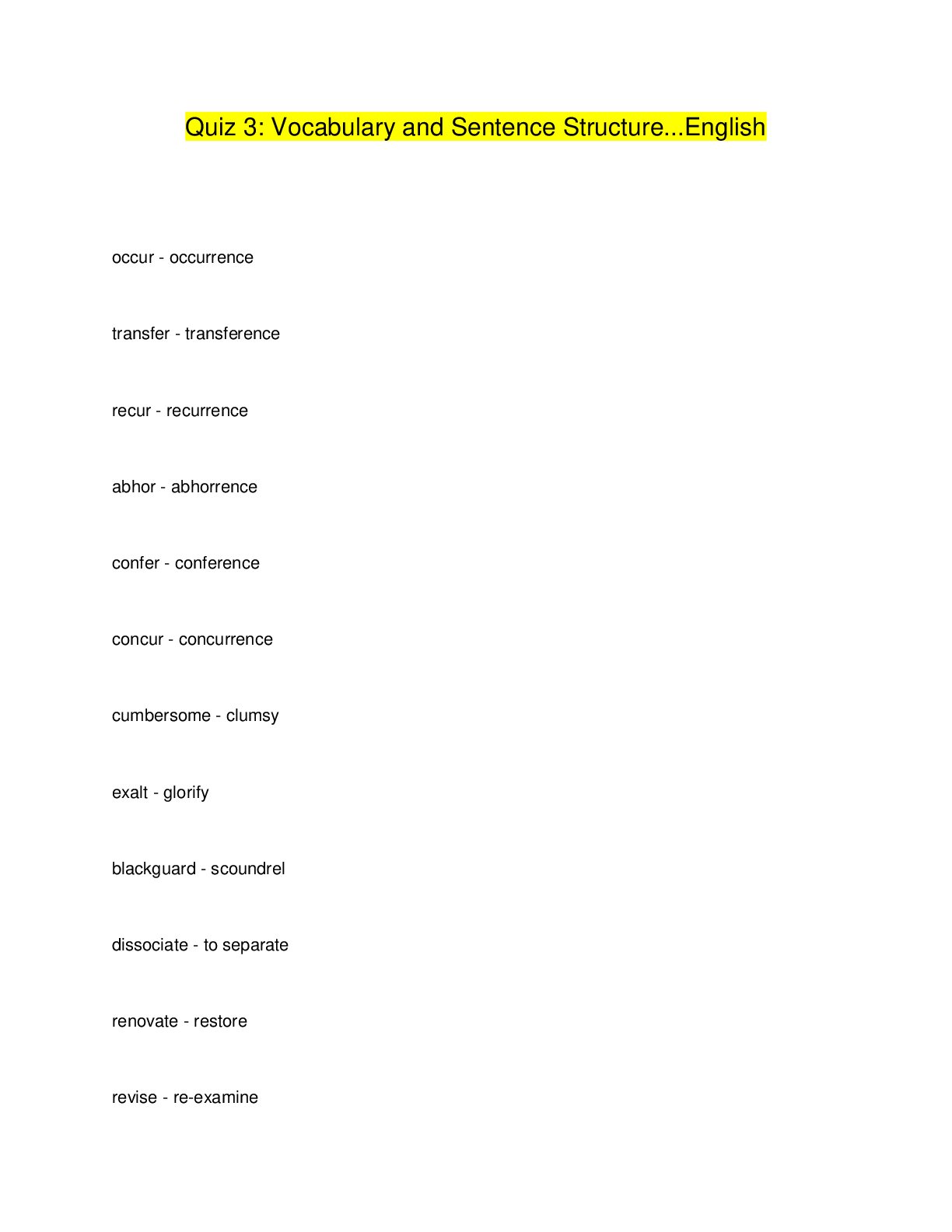*NURSING > Quiz > NURS-6630N-16,Approaches to Treatment.2020 Winter Qtr 11/30-02/21-PT27 Test Quiz - Week 3 (All)
NURS-6630N-16,Approaches to Treatment.2020 Winter Qtr 11/30-02/21-PT27 Test Quiz - Week 3
Document Content and Description Below
Question 1 0 out of 3.75 points Upon blocking a Serotonin reuptake pump, what happens in the synaptic cleft and on the post synaptic cell membrane? Selected Answer: A. The result will be an inc... rease in available Serotonin in the synaptic cleft causing the post synaptic cell to increase the number of Serotonin receptors. Answers: A. The result will be an increase in available Serotonin in the synaptic cleft causing the post synaptic cell to increase the number of Serotonin receptors. B. The result will be an increase in the available Serotonin in the synaptic cleft causing the post synaptic neuron to reduce the number of Serotonin receptors. C. The result will be an increase in Serotonin in the synaptic cleft resulting in an increase in reuptake pumps on the presynaptic neuron. D. The result will be an increase in Serotonin in the synaptic cleft resulting in a decrease in reuptake pumps on the pre-synaptic neuron. Response Feedback: A, C, and D are misrepresentations of what occurs when you increase Serotonin in the synaptic cleft. There is no effect on the pre-synaptic neuron, and the increases in Serotonin result in a reduction of receptor concentration on the post-synaptic neuron. Question 2 0 out of 3.75 points A patient arrives in the ED via EMS having a grand mal seizure. The ED physician instructs the RN to give 10 milligrams of Diazepam IV X1 dose STAT. The patient’s seizure breaks within 2 minutes of the Diazepam being administered. The mechanism by which this medication causes rapid resolution of seizure activity is via which receptor type (effector pathway/receptor subtype)? Selected Answer: C. Rapid effector pathways/G-protein coupled receptor Answers: A. Slow effector pathways/G-protein coupled receptor B. Slow effector pathway/ion channel C. Rapid effector pathways/G-protein coupled receptor D. Rapid effector pathway/ion channel Response Feedback: Options B and C are mismatched, and Option A shows effects days to weeks after activation. Question 3 3.75 out of 3.75 points Neurotransmitters are defined by four essential characteristics. These are: Selected Answer: E. A, C, and D only Answers: A. Neurotransmitters are synthesized within presynaptic neurons. B. Depolarization of a neuron results in the release of a neurotransmitter, which exerts a multitude of actions on the postsynaptic neuron. C. Their action on postsynaptic neurons can be replicated by administering a drug that mimics the activity of the endogenous neurotransmitter. D. Their action in the synaptic cleft is terminated by a specific action. E. A, C, and D only Response Feedback: Answer B should read a “discrete” (not multitude) action on the post synaptic neuron. Question 4 0 out of 3.75 points Introducing adherence in facilitating treatment goals is something that would be necessary in a patient who has previously displayed nonadherence patterns. Selected Answer: A. True Answers: A. True B. Fals e Response Feedback: It is introduced as early as possible in treatment to mitigate the risks associated with nonadherence. Question 5 3.75 out of 3.75 points Of the components of patient-focused interventions to enhance adherence, which component includes the following strategies: adaptive thinking, use of cues, and support? Selected Answer: B. Skills Answers: A. Motivatio n B. Skills C. Logistics D. Educatio n Response Feedback: Skills include adaptive thinking, problem solving, use of cues, and support. Question 6 0 out of 3.75 points Serotonin (5HT) is a neurotransmitter associated with mood, sleep, and psychosis. There are several serotonin receptors all over the human body. A unique aspect of the second generation antipsychotics is their ability to block 5HT2a receptors. What is the effect of this inhibition? Selected Answer: C. Causes hallucinations Answers: A. Stabilizes dopamine concentrations in the CNS B. Induces anxiety C. Causes hallucinations D. Reduces platelet function Response Feedback: B represents antagonism of 5HT1a, C represents a 5HT2a agonist, and D represents what happens when you inhibit SERT [Show More]
Last updated: 2 years ago
Preview 1 out of 11 pages

Buy this document to get the full access instantly
Instant Download Access after purchase
Buy NowInstant download
We Accept:

Reviews( 0 )
$10.00
Can't find what you want? Try our AI powered Search
Document information
Connected school, study & course
About the document
Uploaded On
Sep 23, 2022
Number of pages
11
Written in
Additional information
This document has been written for:
Uploaded
Sep 23, 2022
Downloads
0
Views
66






